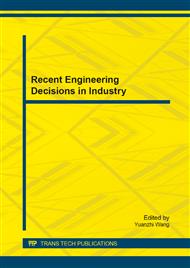[1]
International Code Council, International Building Code (IBC), Falls Church, VA., (2003).
Google Scholar
[2]
Reglamento de construcciones del Distrito Federal, Normas Técnicas Complementarias de Diseño por Sismo, Gaceta Oficial del Distrito Federal, México City, (2004).
DOI: 10.18867/ris.15.400
Google Scholar
[3]
J. Penzien and M. Watabe: Characteristics of 3-Dimensional earthquake ground motions, Earthquake Engineering and Structural Dynamics Volume 3, (1975), pp.365-373.
DOI: 10.1002/eqe.4290030407
Google Scholar
[4]
E. Rosenblueth: Design of Earthquake Resistance Structures, Pentech Press Ltd. (1980).
Google Scholar
[5]
W. Smeby and A. DerKiureghia: Modal combination rules for multi-component earthquake excitation, Earthquake Engineering and Structural Dynamics Volume 13, (1985), pp.1-12.
DOI: 10.1002/eqe.4290130103
Google Scholar
[6]
N.M. Newmark: Seismic design criteria for structures and facilities, Trans-Alaska pipeline system, Proceedings of the U.S. National Conference on Earthquake Engineering (1975), pp.94-103.
Google Scholar
[7]
E. Rosenblueth and H. Contreras: Approximate Design for multi-component Earthquakes, Journal of Engineering Mechanics Division ASCE Volume 103 (1977), pp.895-911.
Google Scholar
[8]
E.L. Wilson, I. Suharwardy and A. Habibullah: A Clarification of the orthogonal effects in a three-dimensional seismic analysis Earthquake Spectra Volume 11(4) (1995), pp.659-666.
DOI: 10.1193/1.1585831
Google Scholar
[9]
O.A. Lopez, A.K. Chopra and J.J. Hernandez: Critical response of structures to multi-component earthquake excitation, Earthquake Engineering and Structural Dynamics Volume 29 (2000), pp.1759-1778.
DOI: 10.1002/1096-9845(200012)29:12<1759::aid-eqe984>3.0.co;2-k
Google Scholar
[10]
O.A. Lopez, J.J. Hernandez, R. Bonilla and A. Fernandez: Response spectra for multi-component structural analysis, Earthquake Spectra, Volume 22(1), (2006), pp.85-113.
Google Scholar
[11]
V. Bisadi and M. Head: Orthogonal effects in nonlinear analysis of bridges subjected to multi-component earthquake excitation, Structures Congress of the American Society of Civil Engineers, Section Bridges, (2010), pp.204-215.
DOI: 10.1061/41130(369)20
Google Scholar
[12]
D. Grant: Response Spectral Matching of Two Horizontal Ground-Motion Components, Journal of Structural Engineering Volume 137(3), (2011), p.289–297.
DOI: 10.1061/(asce)st.1943-541x.0000227
Google Scholar
[13]
A. Reyes-Salazar and A. Haldar: Energy Dissipation at PR Frames Under Seismic Loading, Journal of Structural Engineering ASCE, Volume 127(5), (2001), pp.588-593.
DOI: 10.1061/(asce)0733-9445(2001)127:5(588)
Google Scholar
[14]
A. Reyes-Salazar, A. López-Barraza, L.A. López-López, and A. Haldar: Multiple-Components Seismic Response Analysis–A Critical Review, Journal of Earthquake Engineering, Volume 12(5), (2008), pp.779-799.
DOI: 10.1080/13632460701672979
Google Scholar
[15]
L. Gao and A. Haldar: Nonlinear seismic response of space structures with PR connections, International Journal of Microcomputers in Civil Engineering Volume 10, (1995), pp.27-37.
Google Scholar
[16]
Federal Emergency Management Agency State of the Art Report on Systems Performance of Steel Moment Frames Subjected to Earthquake Ground Shaking, SAC Steel Project, Report FEMA 355C, (2000).
Google Scholar


